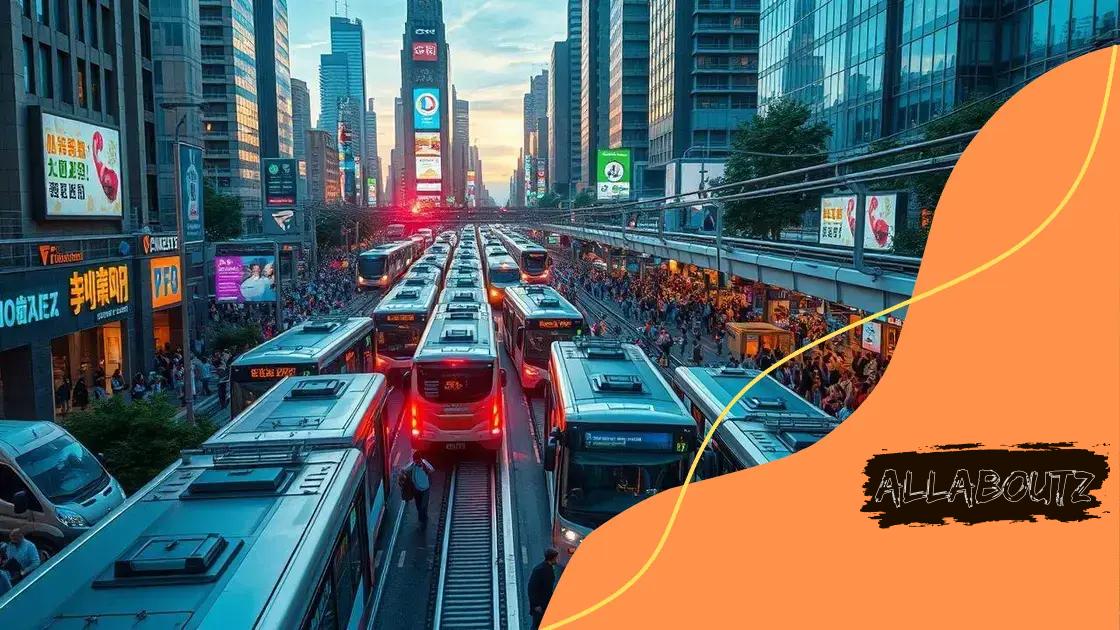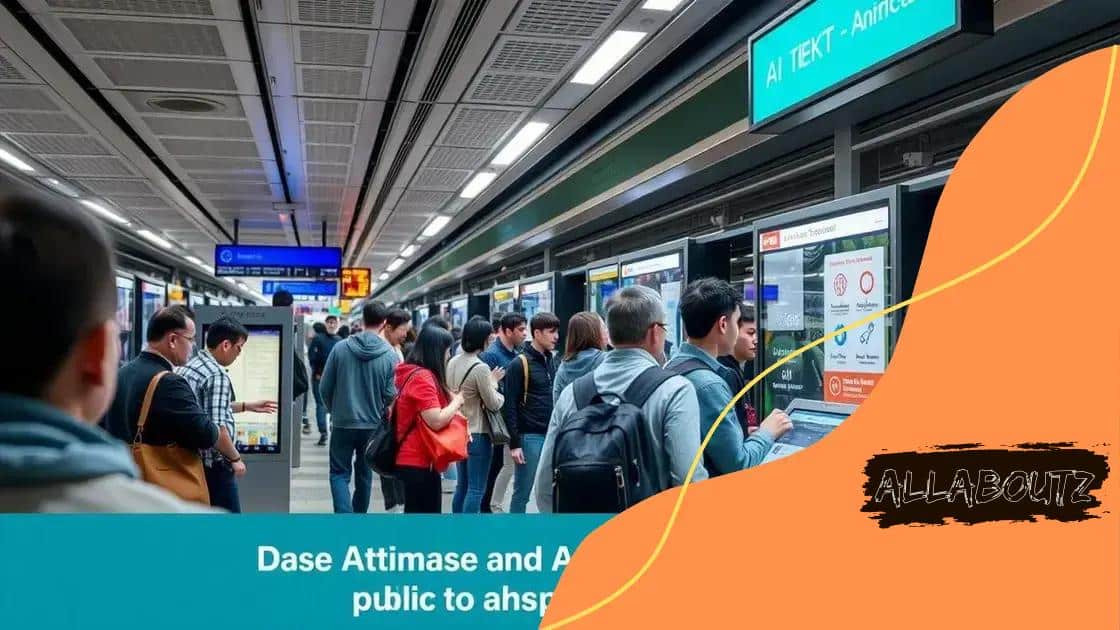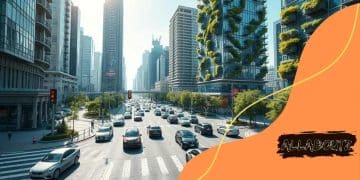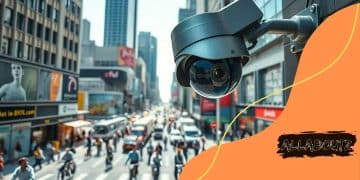The role of AI in public transportation systems

The role of AI in public transportation systems enhances efficiency, safety, and sustainability through innovations like autonomous vehicles, smart traffic management, and big data analytics.
The role of AI in public transportation systems is becoming increasingly significant. Have you ever wondered how technology shapes our daily commutes? Let’s explore these fascinating developments!
Understanding AI’s impact on transit systems
Understanding AI’s impact on transit systems is crucial as technology reshapes how we navigate our cities. With the rapid evolution of artificial intelligence, the way we think about public transport is changing significantly.
One major aspect of AI in transit is its ability to analyze vast amounts of data. This analysis helps improve route efficiency and enhance the overall commuting experience. By utilizing real-time data, AI systems can adapt to fluctuations in transportation demands.
Benefits of AI in Transit
AI offers numerous advantages that can transform transportation networks:
- Improved Safety: AI technologies can foresee potential hazards, helping to prevent accidents.
- Enhanced Efficiency: Systems can optimize schedules and reduce waiting times for passengers.
- Data-Driven Decisions: Transportation agencies can make informed changes based on current usage and trends.
Furthermore, utilizing AI can lead to a more environmentally friendly approach to public transportation. By optimizing routes, AI can help lower fuel consumption and reduce emissions.
Real-World Applications
Cities around the globe are already seeing the benefits of AI integration. For instance, many metropolitan areas have implemented smart traffic management systems that utilize AI to ease congestion. These systems analyze patterns and manage traffic flow based on real-time data.
Moreover, the use of autonomous vehicles is on the rise, further highlighting AI’s capabilities. Cities are experimenting with driverless buses and shuttles that can follow pre-set routes while adapting to unexpected obstacles.
As we continue to explore the potential of AI, it’s essential to understand the challenges that may arise. Ensuring data privacy and addressing the technological divide are crucial to successful implementation.
With the increasing incorporation of AI in public transportation, the overall experience for commuters is set to improve. By investing in AI technologies, cities can provide safer, faster, and more reliable public transport options.
Benefits of AI in public transportation
Benefits of AI in public transportation are rapidly becoming apparent as cities adapt to new technologies. By integrating artificial intelligence, transit systems can enhance efficiency and overall user experience.
One of the key advantages of AI is its capability to analyze data in real-time. This allows transit agencies to adjust routes and schedules based on demand, significantly reducing wait times for passengers. For example, if a bus route experiences higher traffic, AI can suggest adjustments to accommodate the increased load.
Key Advantages of AI
Some of the most notable benefits include:
- Increased Safety: AI systems monitor conditions continuously, identifying risks and alerting operators before issues arise.
- Cost Efficiency: By streamlining operations, AI can help reduce costs associated with fuel, maintenance, and labor.
- Improved Customer Experience: Passengers benefit from real-time updates and adjustments to schedules, leading to a more reliable service.
Moreover, AI can also assist in identifying patterns in passenger behavior. By understanding these trends, transportation authorities can make informed decisions to improve services and infrastructure. For instance, AI can reveal peak travel times, which can help in deploying more vehicles during busy hours.
Environmental Benefits
AI also contributes to environmental sustainability. Optimizing routes not only saves time but also decreases fuel consumption, leading to reduced emissions. Many cities that have adopted AI technologies in public transport have reported lower carbon footprints.
As we look toward the future, incorporating AI into public transportation promises to create smarter, more responsive transit systems. The benefits of AI extend beyond simple convenience; they contribute to enhanced safety, sustainability, and overall quality of life in urban environments.
Challenges facing AI adoption in transit

Challenges facing AI adoption in transit systems present significant hurdles that can slow down progress. As cities embrace technological advancements, understanding these challenges is vital for effective implementation.
One major barrier is the high cost of integrating AI technology. The initial investment in equipment, software, and training can be daunting for transit agencies. Many fear that budget constraints will limit their ability to innovate.
Data Privacy Issues
Another concern involves data privacy. With AI systems processing passenger information, it’s crucial to ensure this data is protected. Effective regulations and standards need to be in place to safeguard users while maintaining trust.
- Transparency: Agencies must communicate how data will be used and stored.
- Security Measures: Implementing robust security features prevents data breaches.
- User Consent: Passengers should have clarity on their rights regarding their personal information.
In addition to privacy, there are challenges related to the existing infrastructure. Many transit systems operate on outdated technologies that may not seamlessly integrate with modern AI solutions. This creates compatibility issues and requires extensive upgrades that can be prohibitive.
Cultural Resistance
Cultural resistance is another obstacle that affects AI adoption. Employees may be reluctant to embrace new technologies due to fears of job loss or change in work dynamics. Training and education are essential to alleviate these concerns and promote a positive mindset toward innovation.
Moreover, public perception plays a crucial role. Passengers might be skeptical about relying on AI for transit decisions. Demonstrating the benefits and reliability of AI solutions can help build confidence in the technology.
Tackling these challenges is essential for cities aiming to harness the full benefits of AI in public transportation. A balanced approach that combines technology with human understanding is key to successful integration.
Case studies of successful AI implementation
Case studies of successful AI implementation provide valuable insights into how artificial intelligence can enhance public transportation systems. These real-world examples help illustrate the potential benefits and effectiveness of AI technologies.
One notable case is in Barcelona, where the city implemented an AI-based traffic management system. This system analyzes real-time data from various sources, such as traffic cameras and sensors, to optimize traffic flow. As a result, congestion has decreased, and travel times for public transport have been significantly reduced.
Chicago Transit Authority (CTA)
Another example comes from the Chicago Transit Authority. They adopted AI-driven predictive maintenance to improve their service reliability. By using sensors and machine learning algorithms, CTA can identify potential equipment failures before they occur. This proactive approach has led to fewer service disruptions and lower maintenance costs.
- Increased service reliability: By anticipating issues, they can maintain smoother operations.
- Cost savings: Reduced downtime means that trains are running more frequently.
- Better customer satisfaction: Passengers enjoy a consistent experience with fewer delays.
In Singapore, the Land Transport Authority has rolled out an AI tool that provides commuters with real-time information on bus arrivals. This tool uses machine learning to predict arrival times based on current traffic conditions. As a result, passengers can plan their journeys more effectively, leading to a more efficient public transport experience.
Los Angeles Metro
Furthermore, the Los Angeles Metro has integrated AI to improve service efficiency through a smart scheduling system. This system adjusts to changing passenger demands and traffic patterns. By analyzing ridership data, it ensures that vehicles are deployed where and when they’re needed most.
These case studies demonstrate the successful application of AI technologies in public transit. By learning from these implementations, other cities can adapt similar strategies to improve their transportation systems.
Future trends in AI for public transport
Future trends in AI for public transport look promising as advancements in technology continue to reshape how we perceive urban mobility. The integration of AI is poised to enhance efficiency, safety, and overall user experience.
One significant trend is the expansion of autonomous vehicles. More cities are exploring the use of driverless buses and shuttles. These vehicles use AI to navigate traffic and respond to real-time conditions, potentially reducing the need for human drivers while increasing operational efficiency.
Smart Traffic Management Systems
Additionally, cities are investing in smart traffic management systems that adapt traffic signals and road configurations based on real-time data. This includes:
- Predictive analytics: Analyzing historical and real-time traffic patterns to optimize flow.
- Adaptive signal control: Changing light timings based on current traffic volume.
- Integrated mobility solutions: Combining various modes of transportation for seamless travel.
Another trend involves the use of big data to enhance public transportation. By analyzing large sets of data, transit agencies can identify patterns in passenger behavior. This can lead to better service planning and improved route design that meets the needs of commuters.
Artificial Intelligence and Sustainability
Moreover, sustainability plays a crucial role in future trends. AI will help optimize energy usage in public transport systems, reducing carbon footprints. For example, electric buses equipped with AI can monitor power consumption and adjust routes to minimize energy use.
The implementation of AI in public transport also encourages a shift toward mobility-as-a-service (MaaS). This model focuses on providing users with various transportation options through a single platform. AI helps streamline and personalize travel experiences by suggesting the best routes and transit modes based on individual preferences.
In conclusion, the future of AI in public transport is bright, with innovations that promise to enhance connectivity, efficiency, and sustainability. As these trends unfold, cities will need to adapt and integrate these technologies to create smarter, more resilient urban transportation systems.
FAQ – Frequently Asked Questions about AI in Public Transportation
What are autonomous vehicles and how do they benefit public transport?
Autonomous vehicles are driverless transportation options that enhance efficiency by reducing human error and optimizing routes based on real-time data.
How does AI improve traffic management systems in cities?
AI improves traffic management by analyzing live traffic data to adjust signals and reduce congestion, leading to faster travel times for public transport.
In what ways can big data analytics help public transportation?
Big data analytics can identify passenger behavior patterns, helping transit agencies optimize routes, schedules, and improve overall service to meet demand.
What role does sustainability play in AI-driven public transport?
Sustainability is key as AI helps reduce energy consumption and emissions, making public transport greener and more eco-friendly.





